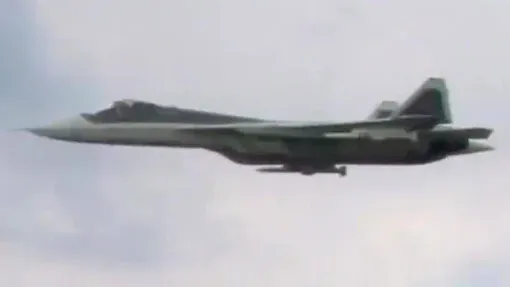Russia shows for the first time the R-77M BVR missile in operation
With AESA seeker, dual-pulse engine and extended range, the R-77M marks a qualitative leap for Russian aviation.
A photograph published by the specialized account La souris (@La_souris_DA) reveals, for the first time, a public image of the Russian R-77M (Izdeliye 180) guided air-to-air missile in actual combat configuration. The image, attributed to Military Avia, shows the new missile mounted under the wing of a fighter jet, during what appears to be an operational sortie.
This image aligns with official video footage released by the Russian Ministry of Defense in October 2020, commemorating the centenary of the 929th Chkalov State Flight Test Center. That video featured Su-57 fighters carrying missiles identified as R-77M, visually confirming the missile’s existence and its integration with Russia’s fifth-generation platform.

More Than an Evolution: A Redesign
Izdeliye 180 represents a substantial modernization within the R-77 (NATO reporting name: AA-12 Adder) missile family, originally developed in the 1980s. Unlike its predecessors—the original R-77 (Izdeliye 170) and the R-77-1 (RVV-SD / Izdeliye 170-1)—the R-77M is not merely an incremental update, but a fundamentally redesigned missile often referred to as a "new weapon" by Russian sources.
Izdeliye 180 introduces several key technical upgrades that set it apart:
- Advanced AESA Seeker: One of its most significant features is an active electronically scanned array (AESA) radar seeker, specifically the upgraded 9B-1348M developed by the Agat Research Institute. This system is designed to offer a “wider field of view” and “immediate response to sudden target maneuvers,” improving hit probability and resistance to electronic countermeasures.
- Dual-Pulse Propulsion: Unlike previous versions with single-pulse motors, the R-77M uses a solid-fuel dual-pulse rocket motor. This configuration allows for an “adjustable delay between pulses” and increased fuel reserves, optimizing the missile’s energy management during flight and extending its kinematic envelope, especially during the terminal phase.
- Optimized Aerodynamics: A visually and functionally notable change is the replacement of the R-77’s distinctive lattice fins with conventional rear fins. This modification primarily aims to reduce aerodynamic drag and radar cross-section (RCS), enabling the missile to be carried internally in the Su-57’s weapon bays while preserving the aircraft’s low observable profile.
These enhancements—alongside an improved datalink, upgraded inertial navigation system, and more powerful batteries—allow the R-77M to achieve an estimated maximum interception range of up to 193 kilometers, according to open sources. This marks a substantial increase over the original R-77’s 80 km and the R-77-1’s 110 km, placing it in the same category as the most advanced BVR missiles currently in service, such as the AIM-120D AMRAAM, the MBDA Meteor, and China’s PL-15.
R-77M: Staying in the BVR Race
The public appearance of the R-77M in an operational setting suggests that Russia is actively renewing its air-to-air missile inventory—possibly in response to the intensive use of BVR weapons in the Ukrainian conflict and the ongoing modernization and reinforcement of NATO’s fighter fleets across Europe. Additionally, the deployment of F-16s in Ukrainian service, with the potential integration of AIM-120D or even Meteor missiles, may be influencing Russia’s doctrinal and developmental priorities.
Alongside the R-77M, more ambitious developments such as the R-77ME (Izdeliye 180-PD) have been reported. This variant, reportedly equipped with a ramjet propulsion system, is not yet confirmed in service but would significantly increase the missile’s range and terminal velocity. In a scenario where control of the air increasingly depends on BVR superiority, these developments reflect Russia’s effort to keep pace in the evolving air-to-air combat environment.

/https://aviacionlinecdn.eleco.com.ar/media/2025/07/caza_su_35_ruso_portando_un_r_77m_izdeliye_180_en_combate.jpeg)
Para comentar, debés estar registradoPor favor, iniciá sesión